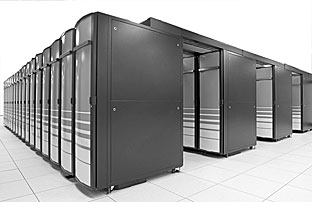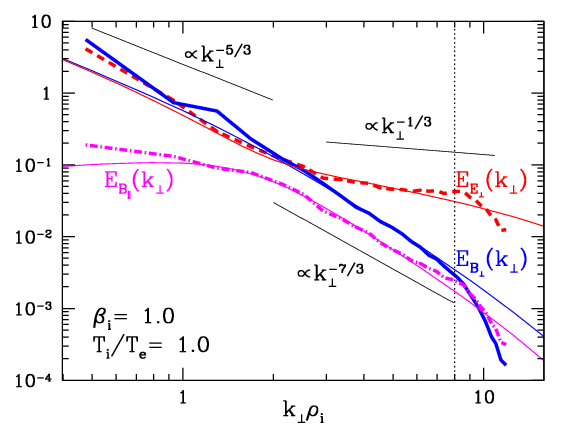High-Performance Computing

The availability of high-performance computing resources—both on the large-scale at national supercomputing centers as well as on smaller scale local clusters—makes possible new approaches to the most challenging scientific questions of our day. Of equal importance as the ground-breaking science being conducted using high-performance computing resources are both the training of future scientists to perform cutting-edge research on supercomputing resources and the continual development of improved algorithms to realize efficient use of the world's top supercomputers.
Here I detail the high-performance computing component of my research program at the University of Iowa, including:
- Training of graduate students and postdocs in scientific computing
- Algorithm and code development to stay at the cutting edge of high-performance computing
- Nonlinear gyrokinetic simulations of kinetic plasma turbulence using the Astrophysical Gyrokinetics Code, AstroGK.
Training in High-Performance Computing
Training future physicists in numerical methods and high-performance computing features as a central goal in the research program I am currently developing at the Universty of Iowa. Some of these efforts are outlined briefly here.
Within my role as a professor in the department, one of my long term goals is to raise the level of computational sophistication within the formal undergraduate and graduate educational curricula. Beginning with my upper division and graduate plasma physics sequence (29:194 Plasma Physics I and 29:195 Plasma Physics II), I am working to incorporate a computational aspect in the course. In addition, I have secured funding for the construction of a local cluster (on the scale of 64-128 processors) for use by my own group for research and by the Department of Physics and Astronomy for education in computational physics.
In addition to the local computing facilities to be constructed at Iowa, my graduate students and postdocs will have access to national supercomputing facilities to which my group has access. Currently, through DOEs INCITE Supercomputing Program, Professor Bill Dorland of the University of Maryland and I have a supercomputing allocation of 4 million cpu-hours for 2008 on Jaguar, a 31,000 core Cray XT-4 at Oak Ridge National Laboratory's National Center for Computational Science.
Advancing Numerical Simulation Capabilities
Advancements in computer architectures lead to nearly a doubing of the available processors, or processing cores, in the nations top supercomputing facilities. The community of computational scientists must take this blistering progress as a serious challenge to improve continually our ability to use those machines to their fullest potential; we must not allow these advances in computer techonoogy to outstrip out ability to use them efficiently. For that reason, the development team for AstroGK expends a substantial fraction of our scientific efforts to improve the algorithms and parallelization schemes of the code on a ongoing basis. Currently, our largest production runs employ about 7,000 processors on Jaguar, the Cray XT-4 at Oak Ridge National Laboratory's National Center for Computational Science. The next generation of supercomputing facilities will provide machines with the order of 100,000 processors for large-scale runs. With our current and future supercomputing allocations, through the DOE's INCITE supercomputing program as well as through other resources, we aim to maintain the ability to use AstroGK efficiently on the most powerful high-performance computing resources available.
Nonlinear Gyrokinetic Simulations of Kinetic Plasma Turbulence
The focal point of my research program is the use of nonlinear gyrokinetic simulations to advance our general understanding of kinetic plasma turbulence. The Astrophysical Gyrokinetics Code, AstroGK, enables numerical simulations of kinetic turbulence over a substantial dynamic range on exisiting high-performance computing resources. The main thrust of these studies is to determine the dissipation of the turbulent fluctuations at small scales via collisionless kinetic mechanisms such as Landau damping. This poorly understood, but fundamentally important, aspect of turbulence in laboratory and astrophysical plasmas is crucial in unraveling the thermodynamics of many important plasma systems.
For example, matter spiraling into a black hole converts a tremendous amount of gravitational potential energy into heat. The radiation that is emitted from the hot, magnetized plasma is a strong function of the black hole properties and of the character of the small-scale plasma fluctuations, where the plasma heating occurs. To understand X-ray observational data from Chandra, one must characterize the small-scale, kinetic plasma turbulence. In the solar wind and in the interstellar medium, there are similar unsolved, interesting problems.

|
My collaborators and I have recently completed our first numerical study of the kinetic turbulent cascade, Kinetic Simulations of Magnetized Turbulence in Astrophysical Plasmas, published in Physical Review Letters in February 2008. This study found magnetic and electric-field energy spectra that showed a break at the ion gyroscale; the spectral slopes were consistent with scaling predictions for critically balanced turbulence of Alfven waves above the ion gyroscale (spectral index -5/3) and of kinetic Alfven waves below the ion gyroscale (spectral indices of -7/3 for magnetic and -1/3 for electric fluctuations). This behavior was also qualitatively consistent with in situ measurements of turbulence in the solar wind. Our findings support the hypothesis that the frequencies of turbulent fluctuations in the solar wind remain well below the ion cyclotron frequency both above and below the ion gyroscale. The figure above presents the resulting magnetic and elcetric energy spectra found our study—see our PRL for more details.
Our current push extends these calculations substantially: to run a suite of first-principles, kinetic turbulence simulations of astrophysical turbulence over the dissipative range of scales from the ion Larmor radius to the electron Larmor radius. These simulations, using AstroGK, aim to resolve the kinetic mechanisms responsible for the dissipation of turbulence in a weakly collisional plasma, leading the way for the development of the theoretical models of kinetic turbulence, enabling direct quantitative comparisons with observations, and providing the data necessary to characterize the resulting plasma heating.